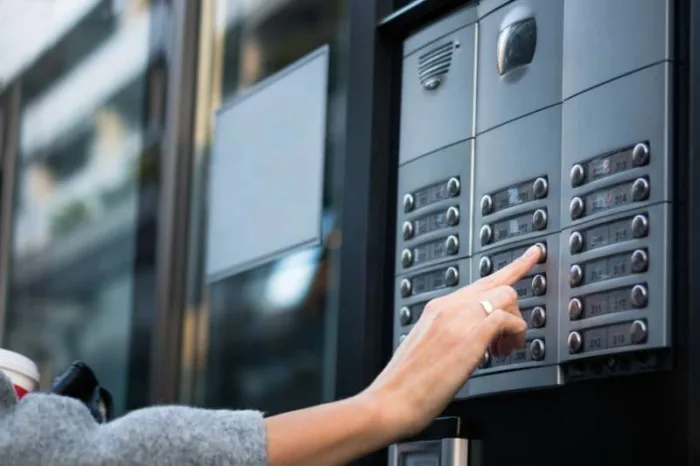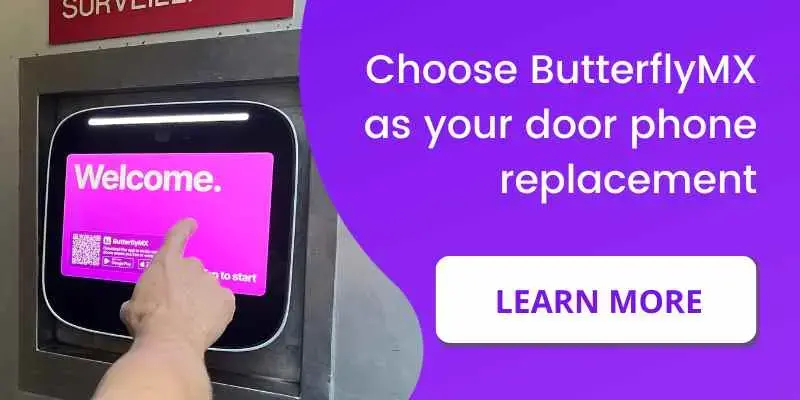Key takeaways
- Door phone intercoms are an amenity residents may appreciate, but they aren’t the most convenient or cost-effective option available.
- Door phone intercoms require extensive hardware and wiring and expensive installation and maintenance.
- A better option is a cloud-based video intercom system. Invest in a smartphone-based video intercom that will hold up for years to come.
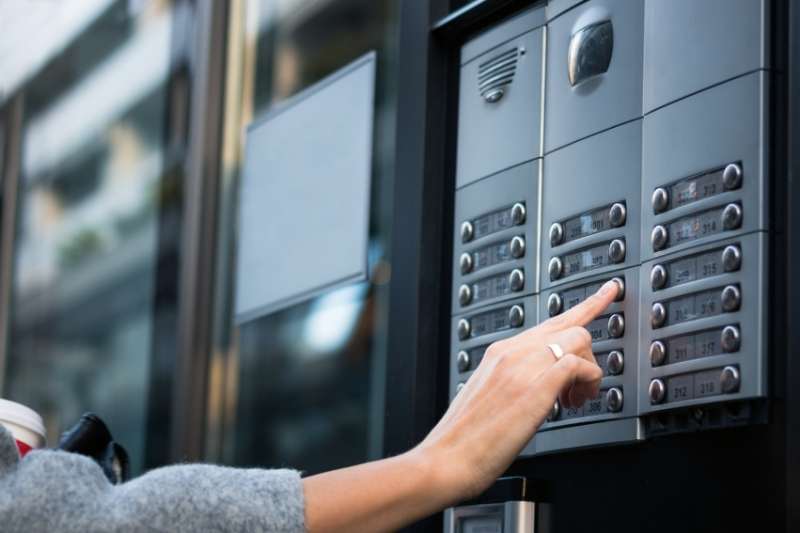
Every property needs a dependable way to monitor and manage property access. Door phones allow you to hand part of that function over to your residents. As a property manager, owner, or developer, you may look into a door phone intercom. But is this the best choice for your property?
In this blog, we define what a door phone intercom is, its components, and how it works. Then, we outline the limitations of door phone intercoms. Finally, we offer modern alternatives that appeal to a wider range of prospective tenants.
This post covers:
- What is a door phone intercom?
- Components of door phone intercom systems
- How does a door phone intercom work?
- 5 limitations of door phone intercoms
- What is the best alternative to a door phone intercom?
What is a door phone intercom?
A door phone intercom is a door entry system that allows residents to control property access using a telephone device installed in their apartment units.
Its function is similar to a doorbell phone intercom system. Door phone intercom hardware is installed in individual units and includes a handset that tenants use to speak with guests at the front entrance of your building.
The in-unit doorphone connects to an outdoor device installed at the property entrance. The system transmits signals between hardware using wiring that connects each in-unit door phone to the front entry hardware. Tenants can speak on the phone with guests and confirm their identity before granting them access.
The door phone intercom is a decent step towards controlled property access. But its excessive hardware and reliance on wiring will impede your ability to create a truly convenient and secure access experience.
Watch how ButterflyMX works:
Components of door phone intercom systems
There are several types of door phone intercom systems to choose from, but each has the same central components.
Central components of door phone intercoms are:
- In-unit doorphone: The in-unit door phone is the actual “phone” part of the intercom. These devices are installed in every unit throughout the property. Tenants use their in-unit devices to answer calls from visitors and press the designated “door open” button to grant access from within their homes.
- Outdoor intercom device: An outdoor intercom device is installed at your property’s front door or gate. Similar to a buzzer box, but with more functionality, the outdoor intercom device allows guests to dial a unit-specific code to speak with a resident directly.
- Door release: Door releases are the mechanisms that unlock your electric and magnetic lock. You’ll need to install a door release mechanism that will remotely unlock the front door or gate when residents grant access to a visitor.
How does a door phone intercom work?
Door phone intercoms allow two-way audio communication between tenants and guests in a residential or commercial building. They also empower tenants to remotely unlock the door or gate for their visitors.
To use, guests at your building look up the tenant they’re visiting within the system’s directory. Once they dial the specific unit code, the system connects to the tenant’s in-unit door phone. If the tenant is home, they answer their door phone and speak with their visitor.
While on the phone, residents press the designated button to activate the door release and grant access to their guests. This button varies depending on the system. Some have a specific “door open” button, while others require tenants to press “9” or another code.
5 limitations of door phone intercoms
Door phone intercoms are quickly becoming outdated as cloud-based entry systems become more widely available. But that’s not the only limitation that door phone intercoms present.
The five main limitations of door phone intercoms are:
- Won’t attract and retain residents
- Residents must be in their units to answer visitors’ calls
- Excessive hardware
- Excessive wiring
- No way to ensure access for deliveries
1. Won’t attract & retain residents
Providing a door phone intercom instead of a modern cloud-based property access system may be a turn-off for prospective tenants. Modern residents look for top-notch security and convenience at their apartments. And a door phone system may lack these highly sought features.
Because door phone intercoms require in-unit hardware, they may be clunky and quickly become aesthetically outdated. Additionally, building ownership or management will likely encounter frequent maintenance issues when in-unit devices break down.
Ultimately, having a door phone intercom instead of a cloud-based video door phone doorbell intercom may avert prospective residents. What’s more, current residents may choose not to renew their lease in favor of a building with modern proptech amenities.
Choosing a door phone intercom system over a video intercom could negatively impact your bottom line whether you own, manage, or develop properties. It’s important to cater to the technological preferences of renters en masse. Opting for a sleek and smartphone-based intercom system will give your building wider appeal than a door phone intercom can.
2. Residents must be in their units to answer visitors’ calls
Convenience is key in ensuring resident satisfaction. A door phone intercom removes the need for residents to leave their unit to let a guest in. However, its perks largely end there.
Because the system isn’t cloud-based, residents must be in their units to grant access to visitors. Residents will have to be home to press the ‘door open’ button on their in-unit devices — there’s no option to remotely unlock the door or gate from a smartphone.
Otherwise, guests will need a copy of the resident’s key to get into the building. Or, they will have to speak directly with property staff to gain access. This is disruptive and inconvenient to everyone involved.
Residents want a property access system that’s convenient all the time, not just when they’re at home.
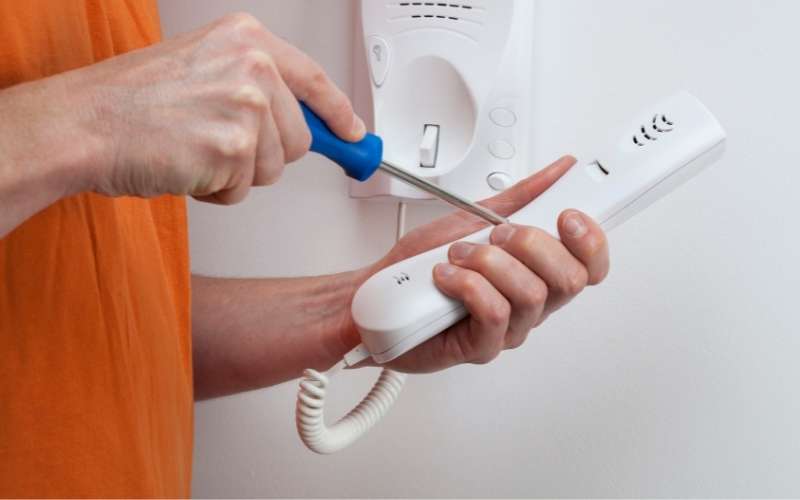
3. Excessive hardware
Door phone intercoms require an in-unit device to be installed in every unit. For multifamily properties with hundreds of units, the cost of hardware and installation will add up quickly.
Because of this, you have to factor in the expense of installing every in-unit device. Additionally, you must calculate the cost of carpentry to open walls and rip up floors to lay wiring.
And if you experience technical problems, you’ll have to pay for a professional to come in person for repairs. This may cause excessive interruptions for your residents.
What’s more, you may decide to replace your door phone intercom after a few years. The cost of uninstalling every device and repairing your units’ walls will be steep.
4. Excessive wiring
Running wires throughout your property to connect each in-unit doorphone to the entryway device is cumbersome and costly. Not to mention, you’ll need to anticipate issues with wiring and budget for repair expenses.
Obviously, for developers, wiring your entire property will be extremely expensive with little payout. And for owners and managers, maintaining the wired devices will require expensive upkeep and maintenance.
This opens the door for inevitable friction as residents expect modern solutions with outdated hardware. Opting for a wireless intercom system is a better investment in the long run.
5. No way to ensure access for deliveries
When you consider that delivery services and online shopping gain popularity every year, guaranteeing convenience for deliveries is of the utmost importance.
Door phone intercoms have no delivery PIN code or delivery pass feature. So, if a courier arrives while a resident isn’t home, they have no way to contact a resident. Instead, they’ll have to call a staff member to request access. And if your door phone intercom doesn’t have an option to call building staff, the courier is out of luck and can’t complete the delivery.
Additionally, if a courier arrives before or after business hours, they may have no way to deliver the package directly. As a result, couriers may need to leave packages outside of the property entrance. This will leave them vulnerable to theft or loss that will inevitably decrease resident satisfaction.
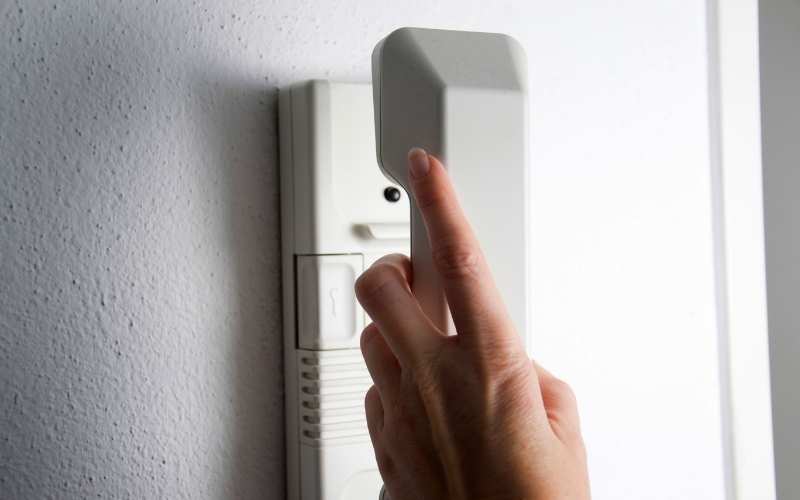
What is the best alternative to a door phone intercom?
Instead of installing a dated door phone intercom system at your property, consider a cloud-based video intercom system.
Society has largely strayed away from landline phones in favor of smartphones. At the same time, we’re also starting to depart from wired intercom systems.
Nearly all of your residents will have at least one smartphone per unit. They handle banking, professional work, social networking, and more on their smartphones. So, integrating property access into their phone activity is a natural next step.
To put it plainly, residents will be happy to use their smartphones and a wireless intercom in place of a wired door phone intercom.
Smart video intercoms allow residents to:
- Grant access to guests and visitors remotely: Residents don’t have to be home to unlock their front door. They may grant or deny access to guests via their smartphone from any location.
- Give temporary access to planned visitors: For example, residents may give a Visitor Pass to their dog walker that works for only the dates and times they specify.
- Chat with guests over video: Residents can easily verify the identity of a guest they know over the phone. But when it comes to visitors they haven’t met, residents will feel safer verifying them visually over video chat.
- Keep a log of all visitors: Systems like ButterflyMX’s video intercom will snap a date and time-stamped photo every time your property’s front door is opened. These photos will be stored and accessible to both residents and property managers.
